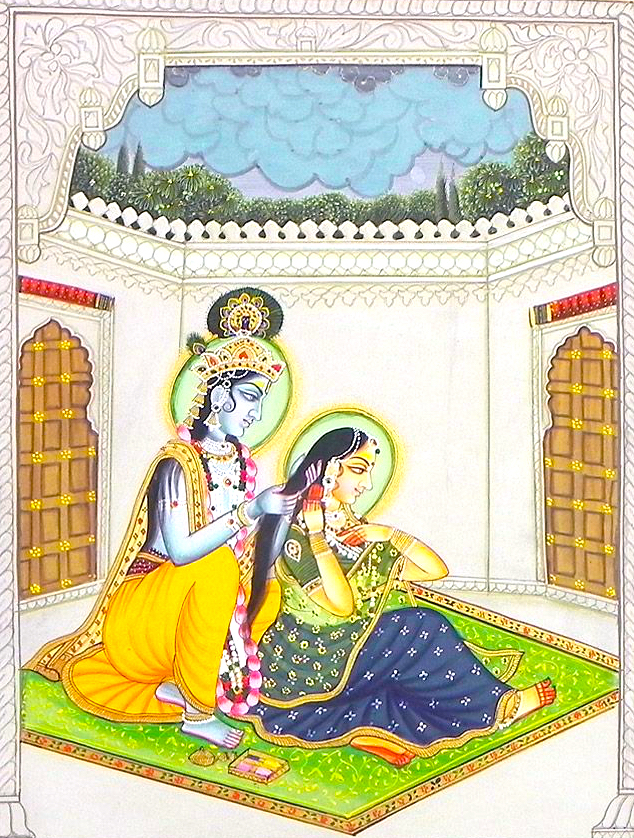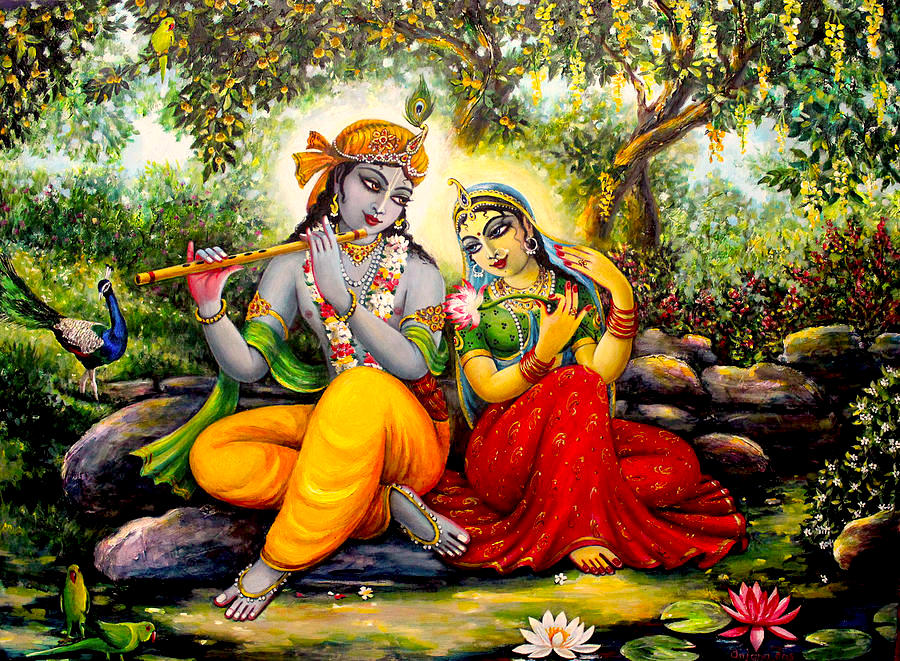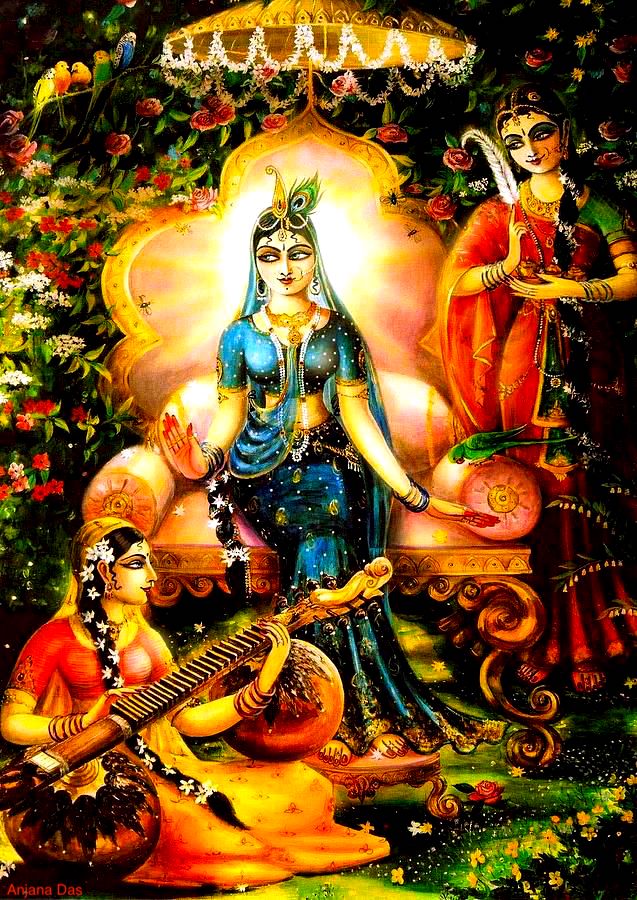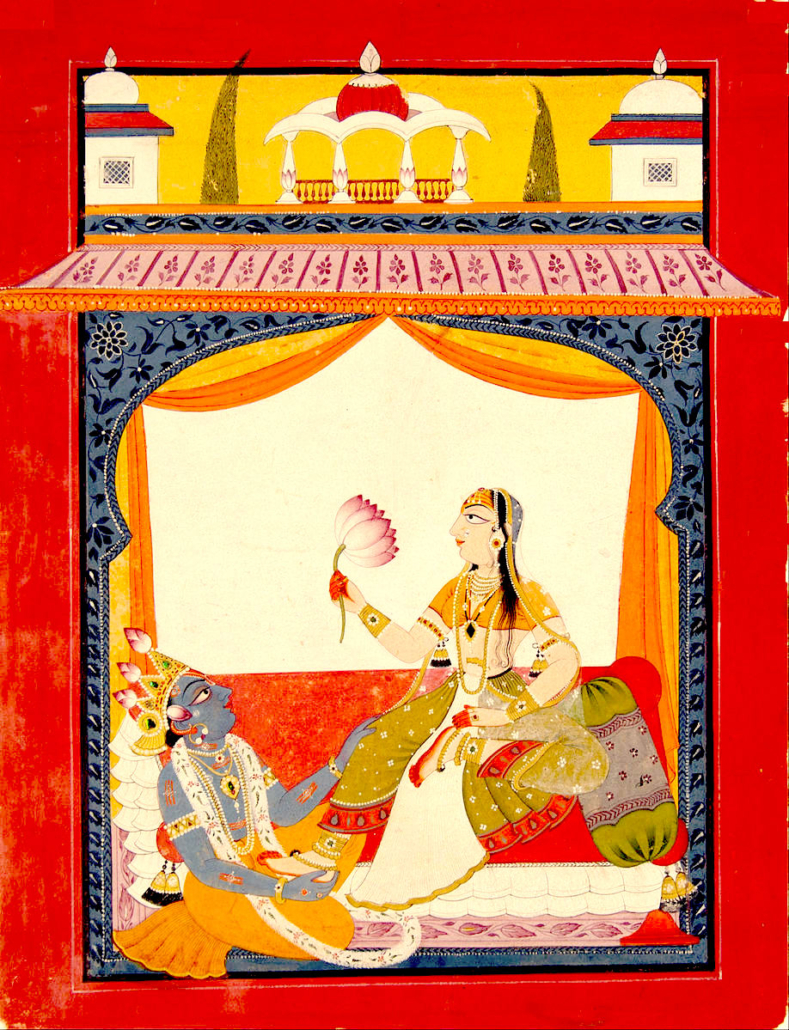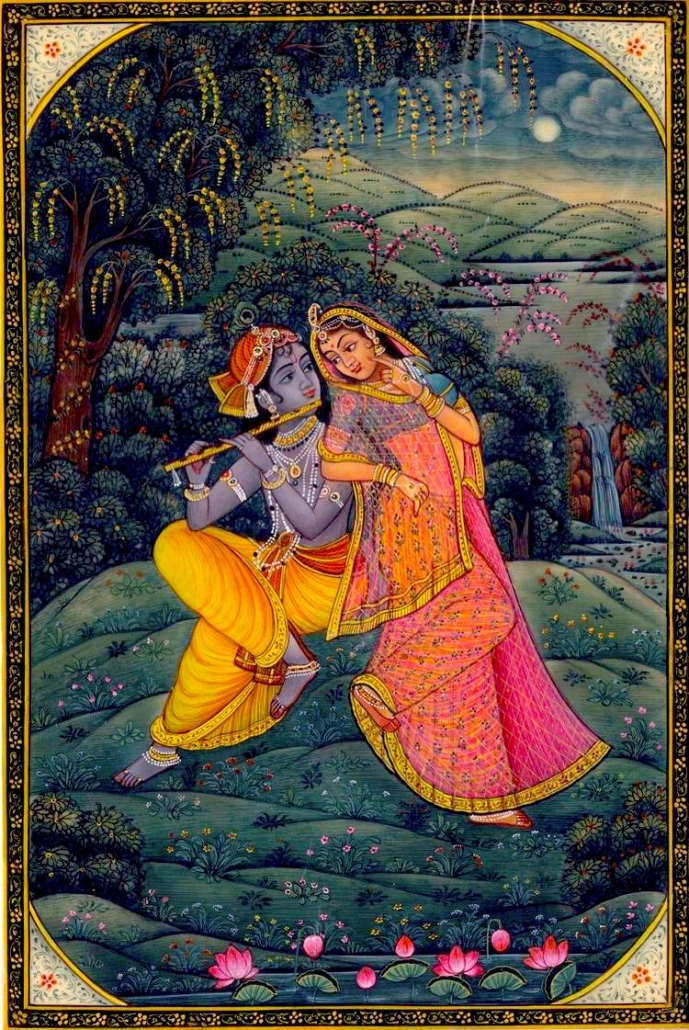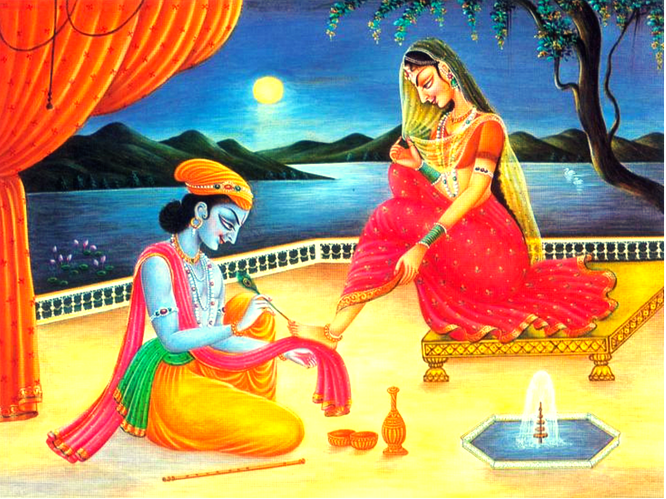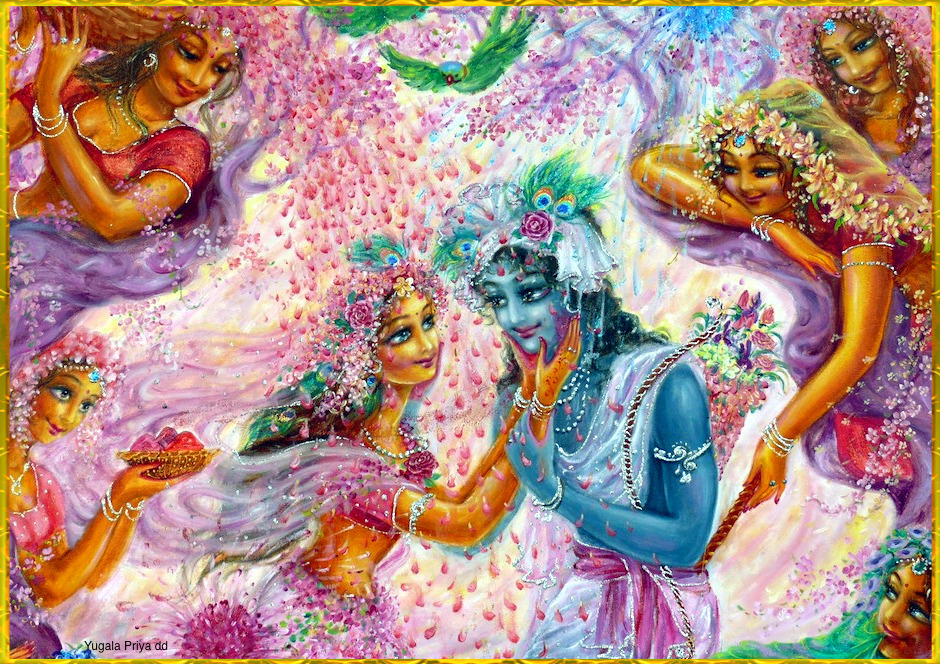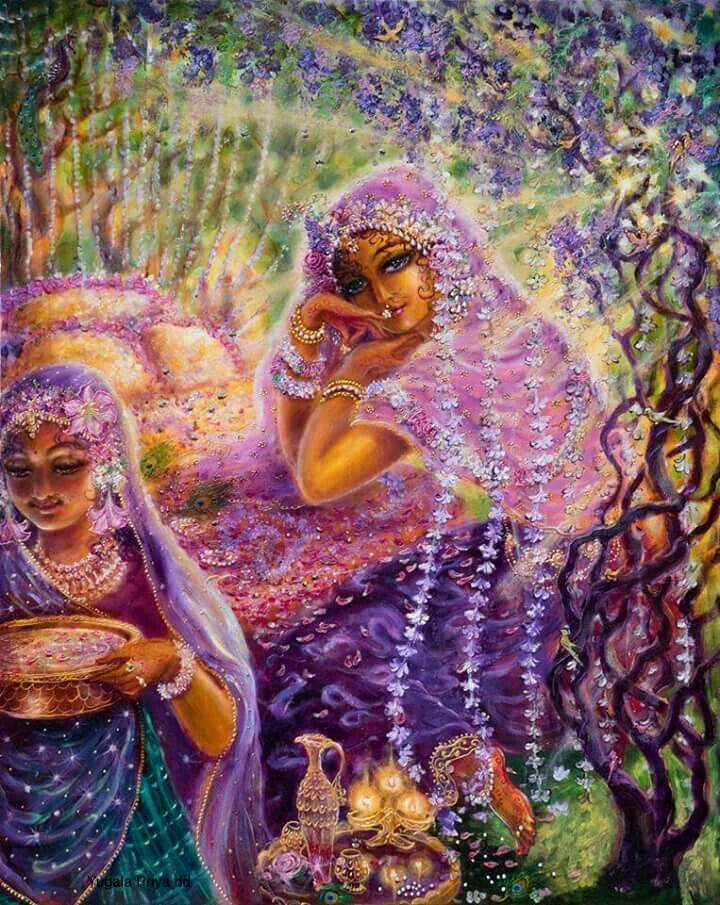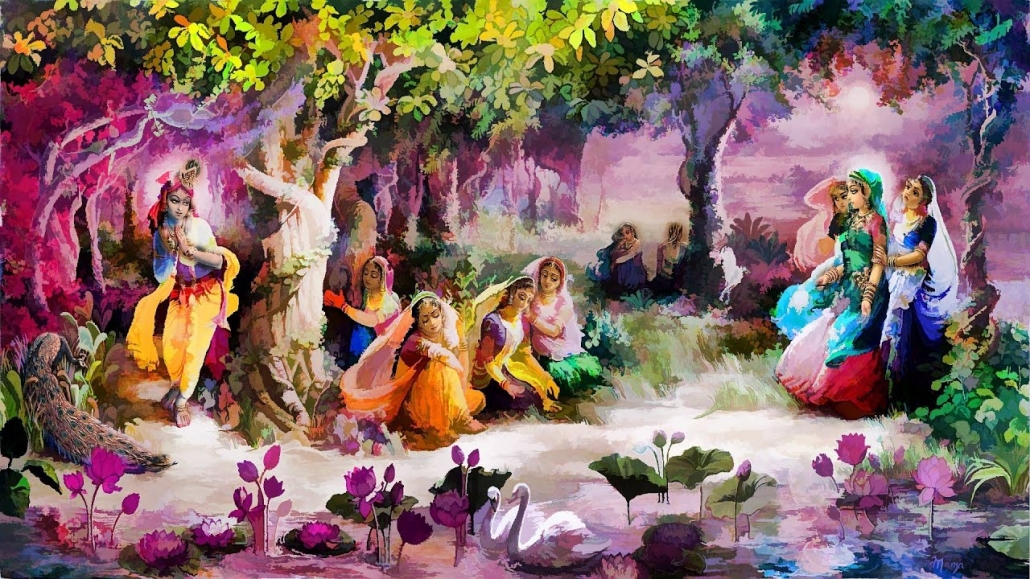Mahanidhi Madan Gopal Das
This series of posts will present facts (tattva) regarding the identity, moods (gopi-bhava), intimacy and sevas of Srimati Radharani’s beautiful and talented handmaidens known as manjaris, kinkaris, or dasis.
Also we will present many astonishing and wonderful lilas to highlight the manjaris most personal and confidential sevas to Srimati Radhika and Her dearest Priyatama Shyamasundara.
The information here is based on the commentaries of Advaitavamsa Acharya 108 Sri Ananda Gopala Goswami and 108 Sri Ananta Dasa Babaji Maharaja taken from “Vilapa Kusumanjali” and “Radha Rasa Sudhanidhi” translated by Sri Advaita Dasji.
Manjari Tattva: Experience in Smaran
Upasana means to hold on to a certain subject of meditation with such one-pointedness that no other subject matter can enter. In Bhakti-rasamrita Sindhu, Sri Rupa Goswamipada cites the following example from Puranas to prove the power of smarana. A brahmin from Pratishthanapura burned his finger after touching an offering of hot sweet rice (kheer) which he had just cooked in his meditation.
In Srimad Bhagavatam (7.1.28), Narada Muni gives the example of the absorption of the grassworm: “The grassworm, who gets trapped in a hole by a hostile bee, becomes a bee also by always thinking of that bee out of fear and enmity.”
If one can go through such a change of body just by meditation, then certainly one can attain a manjari svarupa through intense transcendental meditation. Smarana means: mental association. When a devotee is fully absorbed in Radha-Krishna asta-kaliya lila smarana it is as if one directly serves the Lila Yugala. By simply continuing to meditate on these things the revelations will come.
Sri Caitanya Mahaprabhu confirms this saying;
bhavite -bhavite –Krishna -sphuraye antare
Krishna -krpaya -ajna -paya -rasa -sindhu -pare
“Through constant meditation Krishna will appear in the heart, and by Krishna’s grace even an ignorant soul will cross over the ocean of rasa.” (Caitanya Caritamrita 2.19.236)
Manjari Lila: Reminding Radha of Shyam
One day while bathing Srimati Radharani, Tulasi-manjari reminds Swamini of the sweet history of a painting of Shyamsundar that hangs in Her home.
“O Swamini! I remember you once wrote a letter to Krishna, saying: ‘You are living in My house as a picture and wherever I flee, there You are standing to stop Me with stretched-out arms!’
In this way Tulasi-manjari helps Swamini relish the sweetness of Her previous pastimes and simultaneously brushes Radha’s pretty teeth. Blessed is this maidservant who has nothing in this world except her connection with Sri Radha!
Radha’s kinkaris know exactly how to serve according to time, place and circumstances, bringing all these relishable memories to Bhavamayi’s heart and making Radha swim in waves of rasa!
This is the internal beauty of Radha-dasya that by identifying with the Guru-given siddha svarupa one serves Swaminiji’s ujjvala murti. The raganuga sadhaka identifying with Tulasi-manjari (Sri Raghunatha Dasa Goswami) should feel as if Swamini is taking one by the hand.
The practicing devotee should learn Radha’s various services like tooth brushing by meditating on how the eternally perfect maidservants like Sri Rupa Manjari and Tulasi perform them. These nitya-siddha manjaris are the gurus of the Yugala-seva, who have descended from the Vraja-nikunja along with Sri Caitanya Mahaprabhu to take the neophyte devotees out of this material world, and into Vraja’s nikunjas by teaching them manjari bhava sadhana.
The devotee who is fixed in smarana should be completely free from external consciousness and should identify himself only with his siddha svarupa. The form, sound, touch, taste, and fragrance of Svamini Radha is the only means of survival for such a devotee. A raganuga sadhaka has closed eyes for the material world, and all other thoughts but Radhika’s seva have become insignificant.
When the sadhaka is immersed in remembrance of Sri Radha (smarana- nishtha) it feels as if one is directly serving Radha floating in an ocean of sweet bliss. But when that remembrance recedes and worldly thoughts return, one feels that one has fallen into a desert. Hope for experiences in smarana keeps the sadhaka alive. The hope for attainment takes a seat in the heart of the smarana –anga –sadhaka.
Manjari Lila: Reminding Radha of Rasika Mohan
Madhuri loves Madhava, and the manjaris love Madhuri. One day in Yavata, while Tulasi-manjari is brushing Radha’s beautiful black tresses, she serves Swamini by awakening the remembrance of one of Her sweet sports with Krishna.
Tulasi says: “At the end of Your pastimes in the kunja, Shyam is making Your braid with His own hands, and You are putting on Krishna’s crown. Or sometimes, out of deep love, You may reverse roles. So then Shyam puts His crown on You, and You tie Bihari’s beautiful locks in a veni.
“O Swamini! When can I, Your poor unqualified maidservant, also once serve You as expertly and lovingly as Shyam does? Be merciful and please give me that service! That is my desire!”
While listening to Tulasi-manjari’s harikatha, Radharani becomes overwhelmed and thinks that it is Shyam making Her braid instead of Tulasi. Radhika keeps Her eyes half closed while relishing that thought and feeling.
Raganuga sadhakas should try to remember these sweet pastimes every day. If one continually remembers one’s siddha deha, maya will have no chance to contaminate the devotee’s mind. All of maya’s disturbances are caused by bodily consciousness.
Radharani’s manjaris ki jai! Jai Jai Sri Radhe!

